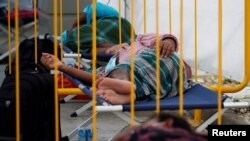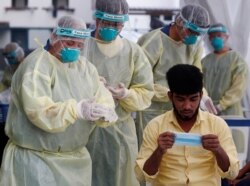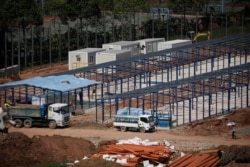Domestic worker Yulia Endang says she is saddened by the stunning burst of COVID-19 cases in Singapore among foreigners. The surge of cases starting in April was a jolt for Singapore, which before then had seemed like a model nation that crushed the disease.
Donning a black hijab with pink roses, Endang says she believes the cramped and overlooked conditions under which foreign workers live contributed to the surge. However she also hopes the bad news will be a wake-up call for the rest of the island nation.
“Knowing what happened to migrant workers and how or why they have become the center of attention is actually very saddening,” she said, adding: “I hope the attention is not just attention but a signal that outside, there are more people aware of how actually migrant workers' life [is] like.”
At the peak of the coronavirus pandemic earlier this year, Singapore had the most cases in Southeast Asia, despite its small population. Though it has now flattened the curve of infections, the surge, mostly in dorms for foreign workers, came as a surprise as it belied the authoritarian state’s reputation for technocratic capacity, including skills to handle emergencies. The episode has been a reminder that, as in several rich societies, Singapore’s prosperity relies in part on blue collar foreign labor that is sometimes ignored.
How has Singapore responded?
After a peak of more than 1,400 cases one day in April, there are now as few as 200 new COVID-19 cases a day in the city-state. Singapore’s main action to deal with the spread among foreign workers — as well as the underlying problems revealed by the spread — has been to focus on health and housing. The state issued a quarantine order on foreign dorms and this month it finished coronavirus testing of all dorm residents.
“This means that all workers living in dormitories have either recovered or have been tested to be free from the virus,” except for those in quarantine, the Singapore Ministry of Manpower said in a press release on Aug. 11.
Moving forward Singapore plans to expand health services for foreign workers, as well as build more housing to relieve the population density that was blamed in part for the COVID-19 outbreak. Some have already been relocated from cramped facilities to newly refurbished buildings. The construction plans include eight dorms by the end of the year.
Non NIMBY cartoons
Beyond logistics, locals are looking for social change to help correct what has historically been a more stratified nation.
A group of Singapore residents is combatting the “not in my backyard” attitude popularly referred to as “NIMBY” with a more inclusive strategy that they call “ Welcome In My Backyard,” or WIMBY.
Endang shared her views through the group, which was formed after the COVID surge to bridge ties between foreign workers and others in Singapore.
Artists have shared a variety of work to promote WIMBY’s message of inclusion: a father-son duet cover of the song “Stand By You;” jewelry art meant to show diversity; cartoons challenging the status quo of what one artist called “marginalized” workers.
Such foreign labor has long been seen as intrinsic to the economy. With more domestic workers like Endang, for instance, Singapore saw that “the gainful entry of its own women into the formal economy has been facilitated,” scholars Shirlena Huang and Brenda Yeoh wrote.
“Let’s challenge this status quo,” the WIMBY group said in a Facebook post. “We must not be comfortable with the idea of riding on the basic livelihoods of others for the success of the economy. Perhaps the ultimate ‘Gold Standard’ Singapore can strive to achieve and be proud of is to cultivate an inclusive and empathetic society?”









